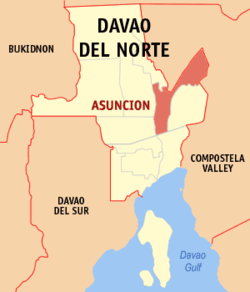Asuncion, Davao del Norte
Asuncion, officially the Municipality of Asuncion (Cebuano: Lungsod sa Asuncion; Tagalog: Bayan ng Asuncion), is a 1st class municipality in the province of Davao del Norte, Philippines. According to the 2015 census, it has a population of 59,322 people.[3]
Asuncion | |
|---|---|
| Municipality of Asuncion | |
 Map of Davao del Norte with Asuncion highlighted | |
OpenStreetMap 
| |
.svg.png) Asuncion Location within the Philippines | |
| Coordinates: 7°32′19″N 125°45′03″E | |
| Country | |
| Region | Davao Region (Region XI) |
| Province | Davao del Norte |
| District | 1st District |
| Barangays | 20 (see Barangays) |
| Government | |
| • Type | Sangguniang Bayan |
| • Mayor | Eufracio P. Dayaday Jr. |
| • Vice Mayor | Joel M. Camello |
| • Congressman | Pantaleon D. Alvarez |
| • Electorate | 36,367 voters (2019) |
| Area | |
| • Total | 297.39 km2 (114.82 sq mi) |
| Population (2015 census)[3] | |
| • Total | 59,322 |
| • Density | 200/km2 (520/sq mi) |
| • Households | 13,700 |
| Economy | |
| • Income class | 1st municipal income class |
| • Poverty incidence | 33.1% (2015)[4] |
| • Revenue (₱) | 162,862,331.69 (2016) |
| Time zone | UTC+8 (PST) |
| ZIP code | 8102 |
| PSGC | |
| IDD : area code | +63 (0)84 |
| Climate type | tropical rainforest climate |
| Native languages | Davawenyo Cebuano Ata Manobo Kalagan language Tagalog |
| Website | www |
Asuncion was formerly known as Saug. It was renamed in 1957.[5]
Barangays
Asuncion is politically subdivided into 20 barangays. Concepcion was elevated from being a sitio to a barrio in 1954.[6] Del Pilar followed suit in 1957.[7]
- Binancian
- Buan
- Buclad
- Cabaywa
- Camansa
- Camoning
- Canatan
- Concepcion
- Doña Andrea
- Magatos
- Napungas
- New Bantayan
- New Santiago
- Pamacaun
- Cambanogoy (Poblacion)
- Sagayen
- San Vicente
- Santa Filomena
- Sonlon
- New Loon
Climate
| Climate data for Asuncion, Davao del Norte | |||||||||||||
|---|---|---|---|---|---|---|---|---|---|---|---|---|---|
| Month | Jan | Feb | Mar | Apr | May | Jun | Jul | Aug | Sep | Oct | Nov | Dec | Year |
| Average high °C (°F) | 28 (82) |
28 (82) |
29 (84) |
31 (88) |
31 (88) |
30 (86) |
30 (86) |
31 (88) |
31 (88) |
31 (88) |
30 (86) |
29 (84) |
30 (86) |
| Average low °C (°F) | 22 (72) |
22 (72) |
22 (72) |
22 (72) |
23 (73) |
24 (75) |
23 (73) |
23 (73) |
23 (73) |
23 (73) |
23 (73) |
23 (73) |
23 (73) |
| Average precipitation mm (inches) | 63 (2.5) |
50 (2.0) |
35 (1.4) |
22 (0.9) |
47 (1.9) |
68 (2.7) |
51 (2.0) |
53 (2.1) |
49 (1.9) |
47 (1.9) |
39 (1.5) |
38 (1.5) |
562 (22.3) |
| Average rainy days | 15.0 | 12.6 | 10.4 | 8.2 | 18.8 | 22.5 | 21.2 | 20.5 | 20.3 | 20.3 | 14.4 | 11.7 | 195.9 |
| Source: Meteoblue [8] | |||||||||||||
History
In 1955, the barrio (barangay) of New Sabonga was transferred to the town of Compostela.[9]
In 2004, Barangays Igangon, Kipalili, Sabangan, Sawata, Santo Niño, and Mamangan was transferred to the create municipality of San Isidro, Davao del Norte.[10]
Demographics
|
| |||||||||||||||||||||||||||||||||||||||||||||
| Source: Philippine Statistics Authority[3][11][12][13] | ||||||||||||||||||||||||||||||||||||||||||||||
See also
- List of renamed cities and municipalities in the Philippines
References
- "Municipality". Quezon City, Philippines: Department of the Interior and Local Government. Retrieved 31 May 2013.
- "Province: Davao del Norte". PSGC Interactive. Quezon City, Philippines: Philippine Statistics Authority. Retrieved 12 November 2016.
- Census of Population (2015). "Region XI (Davao Region)". Total Population by Province, City, Municipality and Barangay. PSA. Retrieved 20 June 2016.
- "PSA releases the 2015 Municipal and City Level Poverty Estimates". Quezon City, Philippines. Retrieved 12 October 2019.
- "An Act Changing the Name of the Municipality of Saug, Province of Davao, to Asuncion". LawPH.com. Archived from the original on 2012-07-11. Retrieved 2011-04-12.
- "An Act Creating the Barrio of Concepcion in the Municipality of Saug, Province of Davao". LawPH.com. Archived from the original on 2012-07-21. Retrieved 2011-04-11.
- "An Act Converting the Sitio of Del Pilar, Municipality of Saug, Province of Davao, into a Barrio to Be Known As Barrio Del Pilar". LawPH.com. Archived from the original on 2012-07-10. Retrieved 2011-04-12.
- "Asuncion: Average Temperatures and Rainfall". Meteoblue. Retrieved 29 February 2020.
- "An Act Making the Barrio of New Sabonga in the Municipality of Saug, Province of Davao, As a Part of the Municipality of Compostela of the Same Province". LawPH.com. Archived from the original on 2012-07-22. Retrieved 2011-04-11.
- National Statistical Coordination Board (2004-08-22). "2004 Factsheet (January to July 2004)". Archived from the original on 15 June 2006. Retrieved 2006-06-24.
- Census of Population and Housing (2010). "Region XI (Davao Region)". Total Population by Province, City, Municipality and Barangay. NSO. Retrieved 29 June 2016.
- Censuses of Population (1903–2007). "Region XI (Davao Region)". Table 1. Population Enumerated in Various Censuses by Province/Highly Urbanized City: 1903 to 2007. NSO.
- "Province of Davao del Norte". Municipality Population Data. Local Water Utilities Administration Research Division. Retrieved 17 December 2016.
External links
This article is issued from Wikipedia. The text is licensed under Creative Commons - Attribution - Sharealike. Additional terms may apply for the media files.